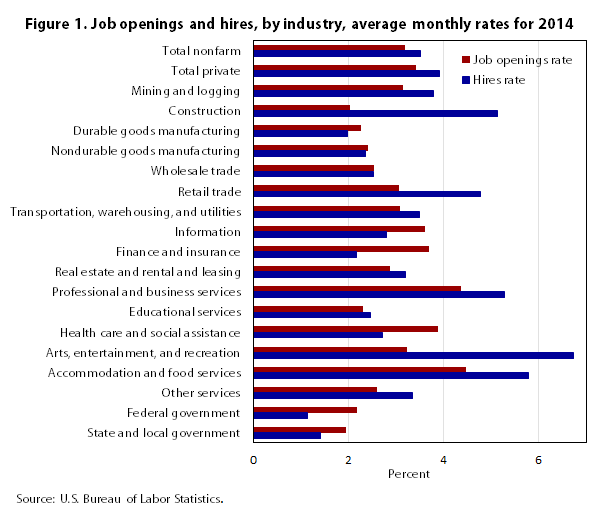Which industries need workers? Exploring differences in labor market activity
Interesting new information from the Bureau of Labor Statistics
Where should new graduates look for jobs? What about career changers? In what direction should career counselors and job placement programs direct clients? Which statistics can government officials use to help determine how to stimulate job growth? How do employers know if their turnover and worker demands are typical? Industries differ in employee turnover patterns, demand for workers, and ability to hire the workers they need. Understanding the labor turnover characteristics of the different industries may help jobseekers, those assisting them, employers, and government officials better focus their efforts.
Where should new graduates look for jobs? What about career changers? In what direction should career counselors and job placement programs direct clients? Which statistics can government officials use to help determine how to stimulate job growth? How do employers know if their turnover and worker demands are typical? Industries differ in employee turnover patterns, demand for workers, and ability to hire the workers they need. Understanding the labor turnover characteristics of the different industries may help jobseekers, those assisting them, employers, and government officials better focus their efforts.
Each data element in the Job Openings and Labor Turnover Survey (JOLTS)—job openings, hires, and separations—provides information about the labor market. However, when all three data elements are studied together, an even more informative picture emerges. The job openings data tell us about the unmet demand for workers; the hires and separations data provide information about the flow of labor. Industries with high turnover and low job openings, such as construction, are easily able to hire the workers they need. But industries with high turnover and high job openings, such as professional and business services, still have open jobs at the end of the month despite their hiring efforts during the month. Those industries with consistently moderate turnover and high unmet demand for labor, such as health care, may be a good option for career changers and students selecting a major, and officials who develop training programs and guide people into them can benefit from knowing which industries these are. Hence, analyzing the demand for and flow of workers by industry could prove helpful both to people looking for work and to those trying to help or hire them.
Job openings and hires
Studying job openings relative to hires reveals substantial differences among the industries. In some cases, hires (measured over the course of a month) are much greater than openings (on the last day of the month); in other cases, the gap between them is small.1 For a few select industries, openings exceed hires. Comparing industries by analyzing the number of openings or hires yields little information because industries vary greatly by size. Converting the number of hires and openings to rates—by dividing the number of hires or openings by the number of people employed in the industry—allows for meaningful cross-industry comparison. Figure 1 presents the hires and job openings rates by industry. For the United States (total nonfarm industries), the job openings rate averaged about 91 percent of the hires rate in 2014. In several industries, the hires rate far exceeded the average job openings rate: construction; arts, entertainment, and recreation; and retail trade. In several industries—for instance, mining and logging, professional and business services, and accommodation and food services—the hires rate exceeded the job openings rate to a lesser degree. The exceptional industries in which the job openings rate exceeded the hires rate were information; finance and insurance; health care and social assistance; federal government; and state and local government.

Comments